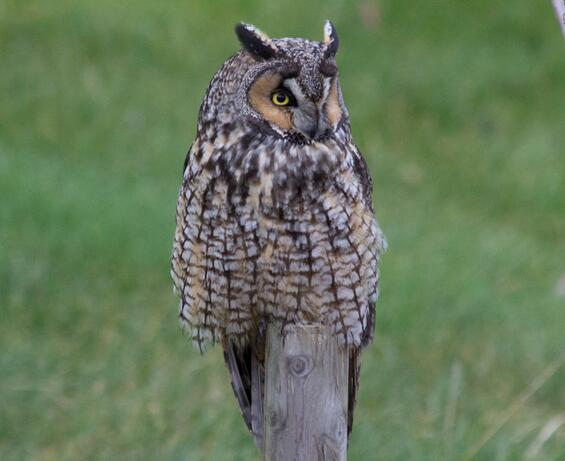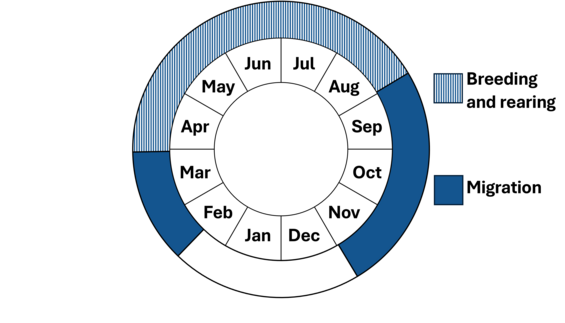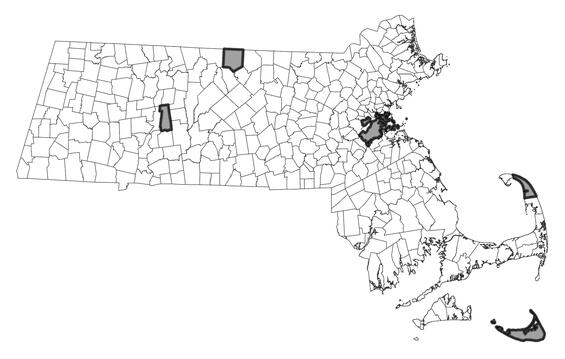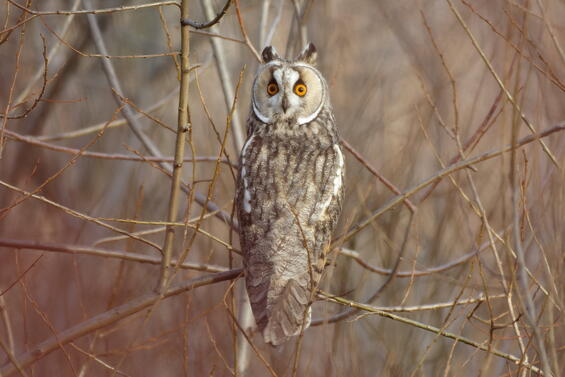- Scientific name: Asio otus
- Species of Greatest Conservation Need (MA State Wildlife Action Plan)
- Special Concern (MA Endangered Species Act)
Description

Long-eared owl (Asio otus)
The long-eared owl is a medium-sized bird, approximately 38 cm (15 in) in length with a 91 cm (36 in) wingspread. In overall coloration it is a soft, mottled grayish-brown with a predominantly plain grayish back and conspicuous dark streaks and bars on its buff-colored underparts. Prominent tawny-orange facial disks, each vertically bisected by a black stripe close to the bill, surround the yellow eyes. Conspicuous, closely-set feathered ear tufts on the top of the head may be variously depressed or extended depending upon an owl’s physical state. In flight the upper sides of the relatively long, rounded wings display buffy patches near the end of each wing; conspicuous black crescents are visible near the bends of each wing on the undersides. Females tend to be slightly larger, darker, and buffier on the underparts than males.
The long-eared owl closely resembles the short-eared owl in size; however, short-eared owls are buffier in overall coloration with more conspicuously streaked underparts, much less prominent ear tufts, and facial disks that are less tawny-colored and exhibit dark patches surrounding their yellow eyes. Short-eared owls are typically found in extensive open areas such as expansive coastal sandplain grasslands and heathlands, as well as open grassy fields and coastal salt marshes in winter. Short-eared owls typically roost on the ground and almost never in the dense coniferous thickets or trees so characteristic of long-eared owls. Also, short-eared owls are routinely seen hunting on cloudy days or at dusk, while long-eared are almost exclusively nocturnal.
Life cycle and behavior

Phenology in Massachusetts. This is a simplification of the annual life cycle. Timing exhibited by individuals in a population varies, so adjacent life stages generally overlap each other at their starts and ends.
The reclusive and nocturnal behaviors of the long-eared owl make it exceedingly challenging to detect and study. It is likely that at least a few long-eared owls are permanent residents in Massachusetts; however, they are most often encountered during migration and in winter, when they occasionally roost communally with up to 20 birds occupying a single roost in years when meadow voles are super-abundant. Local information suggests that spring migrants are moving in March and April, although there are also egg dates for Massachusetts as early as March 15. During late winter and early spring courtship, male long-eared owls advertise by giving a soft, mournful hoot all on one pitch, usually uttered singly or in a short series. At other seasons they produce a variety of other barks, squeals, and mewing calls. Males also engage in flight displays near their nest during which they periodically give mechanical wing-claps that produce whip-like snapping sounds. Copulation usually follows these displays, either on a branch or on the ground and is generally preceded or followed by a bout of mutual head preening.
Long-eared owls do not build a nest, but ordinarily appropriate nests previously built by a squirrel, crow, or hawk. Nests range from 3-10 m (10-30 feet) high and in Massachusetts are generally located in pitch or white pine trees. Egg dates in Massachusetts range from mid-March to mid-May with 4-5 eggs being the usual clutch size. The 26-28 day incubation period is done by the female alone, during which time she is exclusively fed by the male. Since egg-laying is asynchronous, the young hatch over several days and ordinarily remain in the nest for 21-26 days. The male continues to provide food after hatching, although the female does most of the feeding of the young. After fledging the young are fed for approximately 11 weeks, and though they may not remain together during the day, they continue to roost together at night. There tends to be a general dispersal at the end of the season, and the young are apparently capable of breeding the following spring.
Migration in long-eared owls appears to correspond to that of diurnal raptors, with weather and availability of food affecting their behavior from year to year. Although the precise movements of the rare and inconspicuous Massachusetts breeding population are unknown, it is apparent that in some years there is a considerable winter influx that is obviously comprised of birds from beyond the borders of Massachusetts.
The diet of long-eared owls is comprised primarily of meadow voles, along with a small percentage of shrews, white-footed mice, and small songbirds. Nocturnal hunting is accomplished by coursing low over open fields, marshes, and brushy terrain when the species’ keen hearing is critical to successfully locating prey.
Population status
The long-eared owl is listed as a species of Special Concern in Massachusetts. Determining the breeding population of this reclusive species is extremely difficult. Fewer than 10 breeding confirmations have been established in Massachusetts in the past 35 years, and while it is possible that the species may be more widespread than these records would indicate, it is unequivocal that the long-eared owl is a rare breeding species in the Commonwealth.
Distribution and abundance
Long-eared owls are widespread throughout Eurasia and North America, where they breed in Canada from central British Columbia east to Quebec and Nova Scotia, south locally to northern Mexico, central Ohio, and sparingly to Pennsylvania, New York, and New England. In Massachusetts a handful of scattered confirmed breeding records exist for Worcester, Essex, Plymouth, Barnstable, Dukes, and Nantucket counties.

Distribution in Massachusetts. 1999-2024. Based on records in the Natural Heritage Database.
Habitat
Long-eared owls are sufficiently rare and secretive that their precise habitat requirements in Massachusetts are not fully understood. For nesting they generally prefer dense coniferous or mixed forests or groves close to fields or other open areas suitable for foraging. Since they regularly utilize scattered conifer groves and dense thickets in suburban and coastal locations during migration and for winter roosting, it is possible that similar habitats may also occasionally be used for nesting in Massachusetts, especially if there is open habitat nearby for hunting. Healthy habitats are vital for supporting native wildlife and plants. Explore habitats and learn about conservation and restoration in Massachusetts.

Long-eared owl (Asio otus)
Threats
Little is known about long-eared owls in Massachusetts, but potential threats include disturbance at nesting or roosting sites, exposure to rodenticides, loss and degradation of open habitats (urbanization, forest succession) and competition with other species of owls.
Rodenticides (e.g., Second Generation Anticoagulant Rodenticides - SGARs) move up food chains and pose a threat to raptors when they consume prey that have ingested these chemicals. As a result, SGARs have been found in a high percentage of raptors that have been tested for them in Massachusetts, and it is well documented that they can kill individual raptors. However, their population-level impacts on raptors remain largely unknown.
Conservation
Conservation actions to benefit long-eared owls in Massachusetts include protecting nesting/roosting sites from human disturbance and reducing rodenticide use in areas where these birds are known to reside. In areas with known nesting and/or roosting birds, artificial nest baskets could be deployed to promote nesting.
Conduct research to better understand the impacts of highly toxic rodenticides (e.g., SGARs) to raptor populations. Promote an integrated pest management approach that emphasizes the use of alternative pest control measures whenever possible to reduce negative impacts to wildlife. Coordinate with other state agencies to improve tracking and reporting of rodenticides found in wildlife and develop outreach materials for the public.
References
Alderfer, J. (Ed.). 2006. National Geographic Complete Birds of North America. National Geographic, Washington, D.C.
Baicich, P.J., and C.J.O. Harrison. A Guide to the Nests, Eggs, and Nestlings of North American Birds (2nd Ed.). Academic Press, London & New York.
Bent, A.C. 1938. Life Histories of North American Birds of Prey, Part. 2. U.S. Natl. Mus. Bull. No. 170.
DeGraaf, R.M. 2001. New England Wildlife: Habitat, Natural History, and Distribution. University Press of New England, Hanover & London.
Marks, J. S., D. L. Evans, and D. W. Holt (2020). Long-eared owl (Asio otus), version 1.0. In Birds of the World (S. M. Billerman, Editor). Cornell Lab of Ornithology, Ithaca, NY, USA.
Contact
| Date published: | April 22, 2025 |
|---|